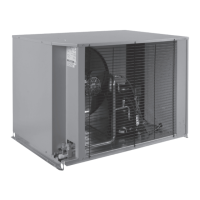
Do you have a question about the Heatcraft BOHN MAC Series and is the answer not in the manual?
| Application | Commercial |
|---|---|
| Heating Capacity | Varies by model |
| Voltage | 208/230V, 460V, 575V |
| SEER Rating | Not applicable (Commercial Refrigeration) |
| HSPF Rating | Not applicable (Commercial Refrigeration) |
| Sound Level | Varies by model (Consult product data sheet) |
| Dimensions (H x W x D) | Varies by model (Consult product data sheet) |
| Weight | Varies by model (Consult product data sheet) |
Responsibility for material receipt and checking for concealed damage.
Guidelines for sloping and insulating suction lines for proper oil return.
Recommendations for installing suction line traps to ensure oil return.
Proper installation and protection of condensate drain lines to prevent freezing and ensure drainage.
Identification of key components and terminals on the Beacon II control board.
Guidance on wiring, sensor handling, and system setup for the Beacon II controller.
Precautions for brazing refrigerant lines to protect electronic components.
Details on connecting the 24 VAC power supply and voltage requirements for the Beacon II.
Guidelines for high and low voltage wiring between condensing and evaporator units.
How to adjust room thermostat settings and understand temperature differentials.
Procedure for charging the system with refrigerant using sight glass.
Checks for wiring, time delay relay, and low pressure switch settings.
System behavior and hold-off cycles upon initial power application.
Understanding the LED display codes for system modes and status.
How to access and modify system parameters using the PROGRAM REVIEW button.
Detailed explanations of various programmable settings like defrost, alarms, and units.
Explains the functionality of MONITOR, FORCE DEFROST, RESET TIME, and FORCE SERVICE buttons.
How to use CLEAR/TEST button and interpret LED status and error codes.
Details on error codes (E1-E9) and their meanings for system faults.
Explanation of system pumpdown cycles and manual pumpdown procedures.
How to place the system into service mode and its effects on operation.
Details on defrost timing, delay, electric, and air defrost modes.
Information on alarm contacts, conditions, and specific alarm codes (A1-A4).
Explanation of system errors (E1-E7, E9) indicated by the LED.
How to shut down evaporator fans and system behavior during power failures.
Using spare terminals and testing sensor functionality and resistance.
Default settings for R-404A refrigerant type and various control parameters.
A diagram illustrating the typical system layout for sensors and piping.
Procedures to verify EEV closing, position monitoring, and pressure response.
How to measure motor winding resistance for suspected EEV malfunction.
Quarterly and semi-annual inspection checklist for condensing units.
Quarterly and semi-annual inspection checklist for unit coolers.
Steps for diagnosing problems like no LED, no compressor run, and low superheat.
Actions for diagnosing compressor shutdown due to LPS, HPS, OPS, or PLM trips.
Diagnosing multi-out/multi-in wiring errors and low voltage display issues.
Steps to diagnose problems where the unit fails to reach the box temperature.
Procedures for entering and exiting the system's service mode.
List of part numbers for various components of the condensing unit.
List of part numbers for various components of the evaporator unit.
List of parts and operational parameters for the Beacon II Smart Controller.
Wiring diagram for air defrost and electric defrost low profile evaporators.
Wiring diagram for the MAC condensing unit, including component labels.
Wiring diagram for connecting the Smart Controller to evaporator units.
